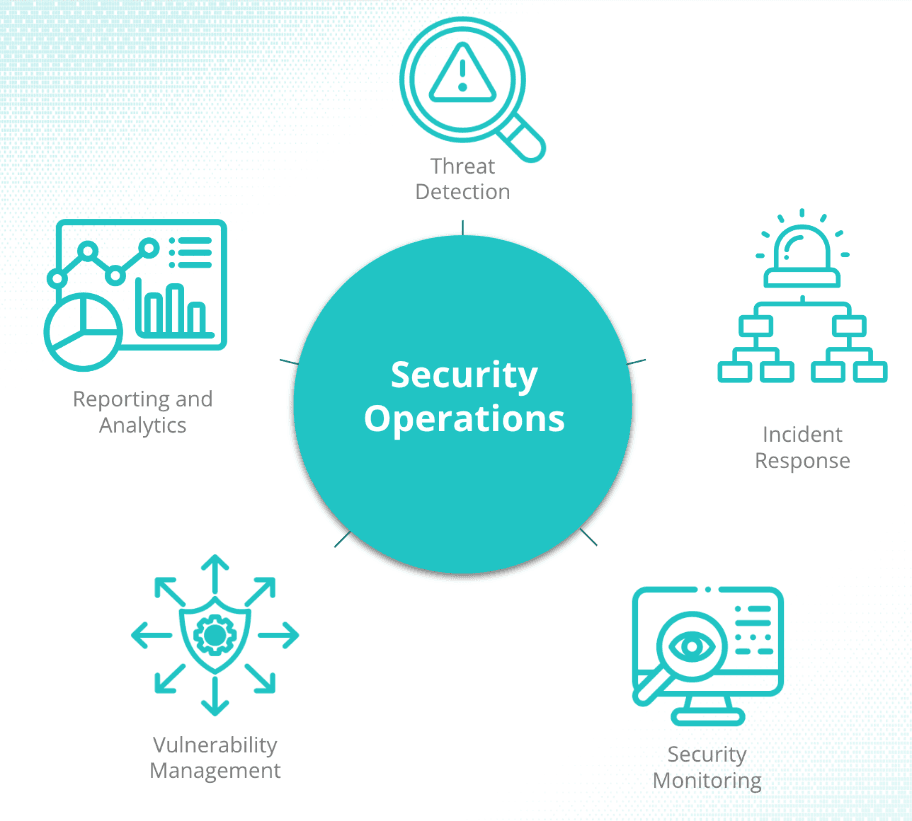SecOps uses а combination of processes, tools, and skilled people to find and respond to cybersecurity threats and incidents.
What is Security Operations (SecOps)?
Security Operations (SecOps) is the integration of security practices into IT operations to enhance an organization’s ability to detect, investigate, and respond to cybersecurity threats and incidents.
It originates from the DevOps movement, which focuses on collaboration between software development and IT operations. SecOps addresses the need for robust security in rapidly evolving IT environments. The goals of SecOps include:
Enhancing the security posture by proactively identifying and mitigating risks;
Improving incident response through efficient detection and reaction protocols;
Ensuring compliance with regulatory and industry standards.
Additionally, SecOps enhances collaboration between security and operations teams. It integrates security throughout the IT lifecycle, optimizing tools and processes with automation and advanced analytics. This streamlines operations, enhancing threat detection and response efficiency.

SecOps vs SOC
Security Operations (SecOps) melds security practices with IT operations, promoting collaboration between security and IT teams to boost overall security. By integrating security measures across the IT lifecycle, SecOps facilitates proactive monitoring, vulnerability management, and automated threat detection.
In contrast, a Security Operations Center (SOC) is a centralized team dedicated to real-time monitoring, detecting, analyzing, and responding to cybersecurity incidents 24/7. They use advanced tools to continuously monitor an organization’s IT infrastructure. While SecOps fosters a holistic, integrated approach to security, a SOC specializes in real-time threat management and incident response.
SecOps Tools
SecOps tools integrate security into IT operations, enhancing security measures and collaboration. Key tools used in SecOps include:
Security Information and Event Management (SIEM). Tools that collect and analyze security data for real-time monitoring, threat detection, and incident response (e.g., Splunk, IBM QRadar).
Network Detection and Response (NDR). Tools that monitor network traffic to detect and respond to suspicious activities and threats (e.g., Darktrace, Vectra AI).
Endpoint Detection and Response (EDR). Tools that monitor and investigate suspicious activities on endpoints to provide advanced threat detection and response (e.g., CrowdStrike, Carbon Black).
Endpoint Protection. Tools that safeguard endpoints against malware and other cyber threats (e.g., Symantec Endpoint Protection, McAfee Endpoint Security).
User and Entity Behavior Analytics (UEBA). Tools that analyze user and entity behavior to detect anomalies and potential insider threats (e.g., Exabeam, Securonix).
Extended Detection and Response (XDR). Tools that integrate multiple security products into a unified system for enhanced threat detection and response (e.g., Palo Alto Networks Cortex XDR, Microsoft Defender XDR).
Security Orchestration, Automation, and Response (SOAR). Tools that automate and orchestrate security operations and incident response workflows to improve efficiency (e.g., Palo Alto Networks Cortex XSOAR, Splunk Phantom).
Vulnerability Management. Tools that identify, prioritize, and remediate security vulnerabilities across systems and applications (e.g., Nessus, Qualys).
Configuration Management. Tools that manage IT asset configurations to ensure compliance with security policies and detect configuration changes (e.g., Ansible, Chef).
Threat Intelligence Platforms (TIP). Tools that aggregate and analyze threat data to deliver actionable intelligence for enhanced threat detection (e.g., ThreatConnect, Anomali).
These tools help SecOps teams proactively identify, manage, and respond to security threats, ensuring a secure and resilient IT environment.
SecOps Challenges
SecOps teams are tasked with protecting digital assets while supporting business operations. This is further complicated by a constantly shifting threat landscape, increasing regulatory demands, and the complexity of modern IT environments. The five fundamental challenges that SecOps teams continually face include:
Integration Complexity. Combining security practices with IT operations requires significant changes to workflows, systems, and processes, making seamless integration difficult.
Collaboration Barriers. Effective communication and cooperation between security and IT teams can be hindered by differing priorities, goals, and organizational cultures.
Skill Shortages. The lack of skilled professionals in cybersecurity and IT operations makes it challenging to implement and manage effective SecOps strategies.
Evolving Threat Landscape. The rapidly changing nature of cyber threats demands constant vigilance and adaptation. This puts pressure on SecOps teams to stay ahead of new and sophisticated attacks.
Data Overload. The vast amounts of security data generated can overwhelm teams, making it difficult to analyze, prioritize, and respond to potential threats efficiently.
Simplify Security Operations with Cribl
Cribl boosts SecOps team efficiency through optimized security data management. Streamlining data collection, processing, and routing, Cribl ensures only pertinent data reaches SIEM systems and analytics platforms, cutting down on data volume and costs. It enhances data with context like geolocation and threat intelligence for swift security incident detection.
Cribl streamlines data normalization across various formats, enhancing analysis and correlation capabilities. Its search-in-place features facilitate swift threat detection and response. Moreover, Cribl aids in historical data analysis by directing data to long-term storage for thorough investigations and trend analysis.
Compliance is maintained as Cribl ensures necessary data retention and facilitates audit report generation. Seamless integrations with existing countless security tools allow SecOps teams to enhance workflows without significant changes. Overall, Cribl improves data quality and access, reduces operational overhead, and accelerates incident response, making SecOps more effective and efficient.








